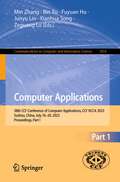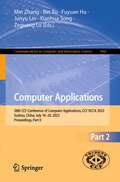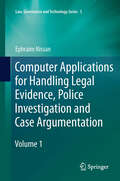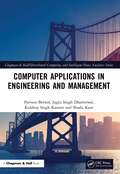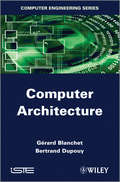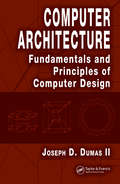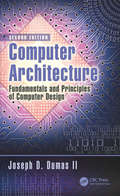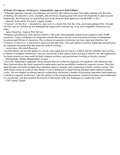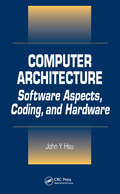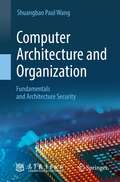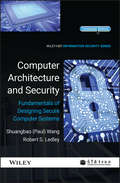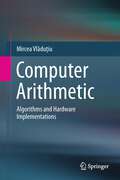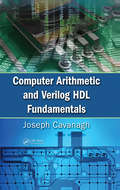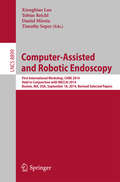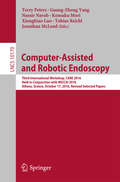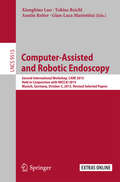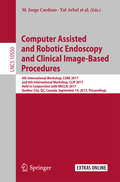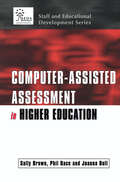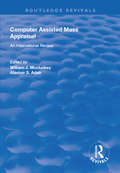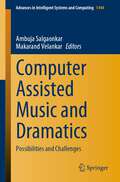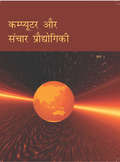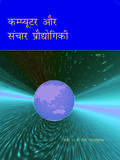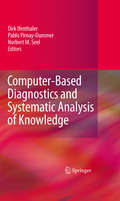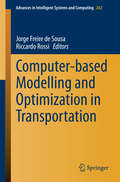- Table View
- List View
Computer Applications: 38th CCF Conference of Computer Applications, CCF NCCA 2023, Suzhou, China, July 16–20, 2023, Proceedings, Part I (Communications in Computer and Information Science #1959)
by Min Zhang Bin Xu Fuyuan Hu Junyu Lin Xianhua Song Zeguang LuThe two-volume set CCIS 1959 and 1960 constitutes the refereed post-conference proceedings of the 38th CCF National Conference on Computer Applications, CCF NCCA 2023, held in Suzhou, China, during July 16–20, 2023.The 39 revised full papers presented in these proceedings were carefully reviewed and selected from 197 submissions. The papers are organized in the following topical sections:Volume I:Artificial intelligence and application.Volume II:Data science and technology; pattern recognition and machine learning; network communication and security; frontier and comprehensive applications.
Computer Applications: 38th CCF Conference of Computer Applications, CCF NCCA 2023, Suzhou, China, July 16–20, 2023, Proceedings, Part II (Communications in Computer and Information Science #1960)
by Min Zhang Bin Xu Fuyuan Hu Junyu Lin Xianhua Song Zeguang LuThe two-volume set CCIS 1959 and 1960 constitutes the refereed post-conference proceedings of the 38th CCF National Conference on Computer Applications, CCF NCCA 2023, held in Suzhou, China, during July 16–20, 2023.The 39 revised full papers presented in these proceedings were carefully reviewed and selected from 197 submissions. The papers are organized in the following topical sections:Volume I:Artificial intelligence and application.Volume II:Data science and technology; pattern recognition and machine learning; network communication and security; frontier and comprehensive applications.
Computer Applications for Business: Step-by-step Exercises and Applications
by Iris BlancComputer Applications for Business will introduce you to word processing, spreadsheet, database and desktop presentation concepts through sequential practice material. Most of the exercises relate to computers. Consequently, while you are doing the exercises, you are also learning about computers. The exercises proceed from basic to intermediate level. Since this book is generic, it may be used with any software or computer. There are five chapters in this book: 1. Word Processing, 2. Spreadsheet, 3. Database, 4. Integration, and 5. Desktop Publishing.
Computer Applications for Handling Legal Evidence, Police Investigation and Case Argumentation (Law, Governance and Technology Series #5)
by Ephraim NissanThis book provides an overview of computer techniques and tools -- especially from artificial intelligence (AI) -- for handling legal evidence, police intelligence, crime analysis or detection, and forensic testing, with a sustained discussion of methods for the modelling of reasoning and forming an opinion about the evidence, methods for the modelling of argumentation, and computational approaches to dealing with legal, or any, narratives. By the 2000s, the modelling of reasoning on legal evidence has emerged as a significant area within the well-established field of AI & Law. An overview such as this one has never been attempted before. It offers a panoramic view of topics, techniques and tools. It is more than a survey, as topic after topic, the reader can get a closer view of approaches and techniques. One aim is to introduce practitioners of AI to the modelling legal evidence. Another aim is to introduce legal professionals, as well as the more technically oriented among law enforcement professionals, or researchers in police science, to information technology resources from which their own respective field stands to benefit. Computer scientists must not blunder into design choices resulting in tools objectionable for legal professionals, so it is important to be aware of ongoing controversies. A survey is provided of argumentation tools or methods for reasoning about the evidence. Another class of tools considered here is intended to assist in organisational aspects of managing of the evidence. Moreover, tools appropriate for crime detection, intelligence, and investigation include tools based on link analysis and data mining. Concepts and techniques are introduced, along with case studies. So are areas in the forensic sciences. Special chapters are devoted to VIRTOPSY (a procedure for legal medicine) and FLINTS (a tool for the police). This is both an introductory book (possibly a textbook), and a reference for specialists from various quarters.
Computer Applications in Engineering and Management (Chapman & Hall/Distributed Computing and Intelligent Data Analytics Series)
by Parveen BerwalThe book Computer Applications in Engineering and Management is about computer applications in management, electrical engineering, electronics engineering, and civil engineering. It covers the software tools for office automation, introduces the basic concepts of database management, and provides an overview about the concepts of data communication, internet, and e-commerce. Additionally, the book explains the principles of computing management used in construction of buildings in civil engineering and the role of computers in power grid automation in electronics engineering. Features Provides an insight to prospective research and application areas related to industry and technology Includes industry-based inputs Provides a hands-on approach for readers of the book to practice and assimilate learning This book is primarily aimed at undergraduates and graduates in computer science, information technology, civil engineering, electronics and electrical engineering, management, academicians, and research scholars.
Computer Architecture
by Gérard Blanchet Bertrand DupouyThis book lays out the concepts necessary to understand how a computer works.For reasons of clarity, the authors have deliberately chosen examples that apply to machines from all eras, without having to water down the contents of the book. This choice helps to show how techniques, concepts and performances have evolved since the first computers.The book is divided into five parts. The first four, which are of increasing difficulty, are the core of the book: "Elements of a Basic Architecture", "Programming Model and Operation", "Memory Hierarchy", "Parallelism and Performance Enhancement". The final part provides hints and solutions to the exercises in the book as well as appendices. The reader may approach each part independently based on their prior knowledge and goals.
Computer Architecture: Fundamentals and Principles of Computer Design
by Joseph D. Dumas IIFuture computing professionals must become familiar with historical computer architectures because many of the same or similar techniques are still being used and may persist well into the future. Computer Architecture: Fundamentals and Principles of Computer Design discusses the fundamental principles of computer design and performance enhancement that have proven effective and demonstrates how current trends in architecture and implementation rely on these principles while expanding upon them or applying them in new ways. Rather than focusing on a particular type of machine, this textbook explains concepts and techniques via examples drawn from various architectures and implementations. When necessary, the author creates simplified examples that clearly explain architectural and implementation features used across many computing platforms. Following an introduction that discusses the difference between architecture and implementation and how they relate, the next four chapters cover the architecture of traditional, single-processor systems that are still, after 60 years, the most widely used computing machines. The final two chapters explore approaches to adopt when single-processor systems do not reach desired levels of performance or are not suited for intended applications. Topics include parallel systems, major classifications of architectures, and characteristics of unconventional systems of the past, present, and future.This textbook provides students with a thorough grounding in what constitutes high performance and how to measure it, as well as a full familiarity in the fundamentals needed to make systems perform better. This knowledge enables them to understand and evaluate the many new systems they will encounter throughout their professional careers.
Computer Architecture: Fundamentals and Principles of Computer Design, Second Edition
by Joseph D. Dumas IINot only does almost everyone in the civilized world use a personal computer, smartphone, and/or tablet on a daily basis to communicate with others and access information, but virtually every other modern appliance, vehicle, or other device has one or more computers embedded inside it. One cannot purchase a current-model automobile, for example, without several computers on board to do everything from monitoring exhaust emissions, to operating the anti-lock brakes, to telling the transmission when to shift, and so on. Appliances such as clothes washers and dryers, microwave ovens, refrigerators, etc. are almost all digitally controlled. Gaming consoles like Xbox, PlayStation, and Wii are powerful computer systems with enhanced capabilities for user interaction. Computers are everywhere, even when we don’t see them as such, and it is more important than ever for students who will soon enter the workforce to understand how they work. This book is completely updated and revised for a one-semester upper level undergraduate course in Computer Architecture, and suitable for use in an undergraduate CS, EE, or CE curriculum at the junior or senior level. Students should have had a course(s) covering introductory topics in digital logic and computer organization. While this is not a text for a programming course, the reader should be familiar with computer programming concepts in at least one language such as C, C++, or Java. Previous courses in operating systems, assembly language, and/or systems programming would be helpful, but are not essential.
Computer Architecture: A Quantitative Approach (The Morgan Kaufmann Series in Computer Architecture and Design)
by John L. Hennessy David A. PattersonComputer Architecture: A Quantitative Approach, Sixth Edition has been considered essential reading by instructors, students and practitioners of computer design for over 20 years. The sixth edition of this classic textbook from Hennessy and Patterson, winners of the 2017 ACM A.M. Turing Award recognizing contributions of lasting and major technical importance to the computing field, is fully revised with the latest developments in processor and system architecture. <p><p>The text now features examples from the RISC V (RISC Five) instruction set architecture, a modern RISC instruction set developed and designed to be a free and openly adoptable standard. It also includes a new chapter on domain specific architectures and an updated chapter on warehouse scale computing that features the first public information on Google's newest WSC.
Computer Architecture: Software Aspects, Coding, and Hardware (Telecommunications And Networking Library)
by John Y. HsuWith the new developments in computer architecture, fairly recent publications can quickly become outdated. Computer Architecture: Software Aspects, Coding, and Hardware takes a modern approach. This comprehensive, practical text provides that critical understanding of a central processor by clearly detailing fundamentals, and cutting edge design features. With its balanced software/hardware perspective and its description of Pentium processors, the book allows readers to acquire practical PC software experience. The text presents a foundation-level set of ideas, design concepts, and applications that fully meet the requirements of computer organization and architecture courses.The book features a "bottom up" computer design approach, based upon the author's thirty years experience in both academe and industry. By combining computer engineering with electrical engineering, the author describes how logic circuits are designed in a CPU. The extensive coverage of a micprogrammed CPU and new processor design features gives the insight of current computer development. Computer Architecture: Software Aspects, Coding, and Hardware presents a comprehensive review of the subject, from beginner to advanced levels. Topics include:o Two's complement numbers o Integer overflow o Exponent overflow and underflow o Looping o Addressing modes o Indexing o Subroutine linking o I/O structures o Memory mapped I/O o Cycle stealing o Interrupts o Multitasking o Microprogrammed CPU o Multiplication tree o Instruction queue o Multimedia instructions o Instruction cache o Virtual memory o Data cache o Alpha chip o Interprocessor communications o Branch prediction o Speculative loading o Register stack o JAVA virtual machine o Stack machine principles
Computer Architecture and Organization: Fundamentals and Architecture Security
by Shuangbao Paul WangIn today’s workplace, computer and cybersecurity professionals must understand both hardware and software to deploy effective security solutions. This book introduces readers to the fundamentals of computer architecture and organization for security, and provides them with both theoretical and practical solutions to design and implement secure computer systems. Offering an in-depth and innovative introduction to modern computer systems and patent-pending technologies in computer security, the text integrates design considerations with hands-on lessons learned to help practitioners design computer systems that are immune from attacks. Studying computer architecture and organization from a security perspective is a new area. There are many books on computer architectures and many others on computer security. However, books introducing computer architecture and organization with security as the main focus are still rare. This book addresses not only how to secure computer components (CPU, Memory, I/O, and network) but also how to secure data and the computer system as a whole. It also incorporates experiences from the author’s recent award-winning teaching and research. The book also introduces the latest technologies, such as trusted computing, RISC-V, QEMU, cache security, virtualization, cloud computing, IoT, and quantum computing, as well as other advanced computing topics into the classroom in order to close the gap in workforce development. The book is chiefly intended for undergraduate and graduate students in computer architecture and computer organization, as well as engineers, researchers, cybersecurity professionals, and middleware designers.
Computer Architecture and Security: Fundamentals of Designing Secure Computer Systems (Wiley-hep Information Security Ser.)
by Shuangbao Paul Wang Robert S. LedleyThe first book to introduce computer architecture for security and provide the tools to implement secure computer systems This book provides the fundamentals of computer architecture for security. It covers a wide range of computer hardware, system software and data concepts from a security perspective. It is essential for computer science and security professionals to understand both hardware and software security solutions to survive in the workplace. Examination of memory, CPU architecture and system implementation Discussion of computer buses and a dual-port bus interface Examples cover a board spectrum of hardware and software systems Design and implementation of a patent-pending secure computer system Includes the latest patent-pending technologies in architecture security Placement of computers in a security fulfilled network environment Co-authored by the inventor of the modern Computed Tomography (CT) scanner Provides website for lecture notes, security tools and latest updates
Computer Arithmetic: Algorithms and Hardware Implementations
by Mircea VlăduţiuThe subject of this book is the analysis and design of digital devices that implement computer arithmetic. The book's presentation of high-level detail, descriptions, formalisms and design principles means that it can support many research activities in this field, with an emphasis on bridging the gap between algorithm optimization and hardware implementation. The author provides a unified view linking the domains of digital design and arithmetic algorithms, based on original formalisms and hardware description languages. A feature of the book is the large number of examples and the implementation details provided. While the author does not avoid high-level details, providing for example gate-level designs for all matrix/combinational arithmetic structures. The book is suitable for researchers and students engaged with hardware design in computer science and engineering. A feature of the book is the large number of examples and the implementation details provided. While the author does not avoid high-level details, providing for example gate-level designs for all matrix/combinational arithmetic structures. The book is suitable for researchers and students engaged with hardware design in computer science and engineering.
Computer Arithmetic and Verilog HDL Fundamentals
by Joseph Cavanagh<p>Verilog Hardware Description Language (HDL) is the state-of-the-art method for designing digital and computer systems. Ideally suited to describe both combinational and clocked sequential arithmetic circuits, Verilog facilitates a clear relationship between the language syntax and the physical hardware. It provides a very easy-to-learn and practical means to model a digital system at many levels of abstraction. <p>Computer Arithmetic and Verilog HDL Fundamentals details the steps needed to master computer arithmetic for fixed-point, decimal, and floating-point number representations for all primary operations. Silvaco International’s SILOS, the Verilog simulator used in these pages, is simple to understand, yet powerful enough for any application. It encourages users to quickly prototype and de-bug any logic function and enables single-stepping through the Verilog source code. It also presents drag-and-drop abilities. <p>Designed for electrical and computer engineers and computer scientists, this book leaves nothing unfinished, carrying design examples through to completion. The goal is practical proficiency. To this end, each chapter includes problems of varying complexity to be designed by the reader.</p>
Computer-Assisted and Robotic Endoscopy: First International Workshop, CARE 2014, Held in Conjunction with MICCAI 2014, Boston, MA, USA, September 18, 2014. Revised Selected Papers (Lecture Notes in Computer Science #8899)
by Xiongbiao Luo Tobias Reichl Daniel Mirota Timothy SoperThis book constitutes the refereed proceedings of the First International Workshop on Computer Assisted and Robotic Endoscopy, CARE 2014, held in conjunction with MICCAI 2014, in Boston, MA, USA, in September 2014. The 12 papers presented focus on recent technical advances associated with computer vision; graphics; robotics and medical imaging; external tracking systems; medical device control systems; information processing techniques; endoscopy; planning and simulation.
Computer-Assisted and Robotic Endoscopy: Third International Workshop, CARE 2016, Held in Conjunction with MICCAI 2016, Athens, Greece, October 17, 2016, Revised Selected Papers (Lecture Notes in Computer Science #10170)
by Xiongbiao Luo Tobias Reichl Kensaku Mori Guang-Zhong Yang Terry Peters Nassir Navab Jonathan McleodThis book constitutes the refereed proceedings of the First International Workshop on Computer Assisted and Robotic Endoscopy, CARE 2014, held in conjunction with MICCAI 2014, in Boston, MA, USA, in September 2014. The 12 papers presented focus on recent technical advances associated with computer vision; graphics; robotics and medical imaging; external tracking systems; medical device control systems; information processing techniques; endoscopy; planning and simulation.
Computer-Assisted and Robotic Endoscopy: Second International Workshop, CARE 2015, Held in Conjunction with MICCAI 2015, Munich, Germany, October 5, 2015, Revised Selected Papers (Lecture Notes in Computer Science #9515)
by Xiongbiao Luo Tobias Reichl Austin Reiter Gian-Luca MariottiniThis book constitutes the thoroughly refereedpost-conference proceedings of the Second International Workshop on ComputerAssisted and Robotic Endoscopy, CARE 2015, held in conjunction with MICCAI2015, in Munich, Germany, in October 2015. The 15 revised full papers were carefully selected out of20 initial submissions and focus on recent technical advances associated withcomputer vision; graphics; robotics and medical imaging; external trackingsystems; medical device control systems; information processing techniques;endoscopy; planning and simulation.
Computer Assisted and Robotic Endoscopy and Clinical Image-Based Procedures
by M. Jorge Cardoso Tal Arbel Xiongbiao Luo Stefan Wesarg Tobias Reichl Miguel Ángel González Ballester Klaus Drechsler Terry Peters Marius Erdt Kensaku Mori Marius George Linguraru Andreas Uhl Cristina Oyarzun Laura Raj Shekhar Jonathan McLeodThis book constitutes the refereed joint proceedings of the 4th International Workshop on Computer Assisted and Robotic Endoscopy, CARE 2017, and the 6th International Workshop on Clinical Image-Based Procedures: Translational Research in Medical Imaging, CLIP 2017, held in conjunction with the 20th International Conference on Medical Imaging and Computer-Assisted Intervention, MICCAI 2017, in Québec City, QC, Canada, in September 2017. The 7 full papers presented at CARE 2017 and the 10 full papers presented at CLIP 2017 were carefully reviewed and selected. The papers deal with interventional and diagnostic endoscopy integrating the latest advances in computer vision, robotics, medical imaging and information processing and the development and evaluation of new translational image-based techniques in the modern hospital.
Computer-assisted Assessment of Students (SEDA Series)
by Phil Race Sally Brown Joanna BullThis text draws on a range of expertise to share good practice and explore new ways of using appropriate technologies in assessment. It provides a strategic overview along with pragmatic proposals for the use of computers in assessment.
Computer Assisted Mass Appraisal: An International Review (Routledge Revivals)
by William J. McCluskey Alastair AdairFirst published in 1997, this volume emerged in response to the need for material on the research, development, use and application of mass appraisal techniques for ad valorem property tax systems. The primary paradigms discussed include regression, base home technique, adaptive estimation procedure and artificial neural networks. Intending to address a wide range of property types, the authors explored residential, condominiums, retail, office and industrial property as well as agricultural and forestry land.
Computer Assisted Music and Dramatics: Possibilities and Challenges (Advances in Intelligent Systems and Computing #1444)
by Ambuja Salgaonkar Makarand VelankarThis book is intended for researchers interested in using computational methods and tools to engage with music, dance and theatre. The chapters have evolved out of presentations and deliberations at an international workshop entitled Computer Assisted Music and Dramatics: Possibilities and Challenges organized by University of Mumbai in honour of Professor Hari Sahasrabuddhe, a renowned educator and a pioneering computational musicologist (CM) of Indian classical music. The workshop included contributions from CM as well as musicians with a special focus on South Asian arts. The case studies and reflective essays here are based on analyses of genres, practices and theoretical constructs modelled computationally. They offer a balanced and complementary perspective to help innovation in the synthesis of music by extracting information from recorded performances. This material would be of interest to scholars of the sciences and humanities and facilitate exchanges and generation of ideas.
Computer Aur Sanchaar Prodhogiki Bhag 1 class 11 - NCERT Board: कम्प्यूटर और संचार प्रौद्योगिकी भाग 1 कक्षा 11 - एनसीईआरटी
by Rashtriy Shaikshik Anusandhan Aur Prashikshan Parishadकम्प्यूटर और संचार प्रौद्योगिकी भाग 1 कक्षा 11 वीं का पुस्तक हिंदी भाषा में राष्ट्रीय शैक्षिक अनुसंधान और प्रशिक्षण परिषद् ने प्रकाशित किया गया है । इस पाठ्यपुस्तक में छ: विषय-वस्तुओं/ यूनिटों के अंतर्गत चौदह अध्याय हैं, अर्थात् कम्प्यूटर तथा संचार प्रौद्योगिकी (Computer and Communication Technology - CCT) के संसार में स्वागत; कार्यस्थल उत्पादकता उपकरण संचार अवधारणाएं एवं कुशलताएँ; वेब प्रकाशन प्रौद्योगिकी; सामूहिक कार्य (टीमवर्क) तथा वेब आधारित सहयोग उपकरण और उभरती हुई प्रौद्योगिकियाँ। यह पुस्तक निष्ठापूर्वक तैयार की गई है और पाठ्यपुस्तक विकास समूह, स्कूलों के अध्यापक, विषय विशेषज्ञ, शिक्षाविद् और सरकारी, गैर-सरकारी तथा निजी संस्थाओं / संगठनों के तकनीकी विशेषज्ञ के सतत प्रयासों का परिणाम है । छात्र उच्च माध्यमिक स्तर के बाद भी कम्प्यूटर के बारे में अध्ययन जारी रख सकते हैं और नहीं भी, किंतु ऐसा प्रतीत होता है कि वे सीसीटी के पीछे निहित तर्क को किसी भी अन्य शाखा में उपयोगी पाएँगे, चाहे वह प्रशासन हो, सामाजिक विज्ञान हो, पर्यावरण, अभियांत्रिक (इंजीनियरिंग), प्रौद्योगिकी, जैविकी, चिकित्सा या ज्ञान की कोई भी अन्य शाखा हो ।
Computer Aur Sanchaar Prodhogiki Bhag 2 class 11 - NCERT Board: कम्प्यूटर और संचार प्रौद्योगिकी भाग 2 कक्षा 11 - एनसीईआरटी
by Rashtriy Shaikshik Anusandhan Aur Prashikshan Parishadकम्प्यूटर और संचार प्रौद्योगिकी भाग 2 कक्षा 11 वीं का पुस्तक हिंदी भाषा में राष्ट्रीय शैक्षिक अनुसंधान और प्रशिक्षण परिषद् ने प्रकाशित किया गया है । इस पाठ्यपुस्तक में छ: विषय-वस्तुओं/ यूनिटों के अंतर्गत चौदह अध्याय हैं, अर्थात् कम्प्यूटर तथा संचार प्रौद्योगिकी (Computer and Communication Technology - CCT) के संसार में स्वागत; कार्यस्थल उत्पादकता उपकरण संचार अवधारणाएं एवं कुशलताएँ; वेब प्रकाशन प्रौद्योगिकी; सामूहिक कार्य (टीमवर्क) तथा वेब आधारित सहयोग उपकरण और उभरती हुई प्रौद्योगिकियाँ। यह पुस्तक निष्ठापूर्वक तैयार की गई है और पाठ्यपुस्तक विकास समूह, स्कूलों के अध्यापक, विषय विशेषज्ञ, शिक्षाविद् और सरकारी, गैर-सरकारी तथा निजी संस्थाओं / संगठनों के तकनीकी विशेषज्ञ के सतत प्रयासों का परिणाम है । छात्र उच्च माध्यमिक स्तर के बाद भी कम्प्यूटर के बारे में अध्ययन जारी रख सकते हैं और नहीं भी, किंतु ऐसा प्रतीत होता है कि वे सीसीटी के पीछे निहित तर्क को किसी भी अन्य शाखा में उपयोगी पाएँगे, चाहे वह प्रशासन हो, सामाजिक विज्ञान हो, पर्यावरण, अभियांत्रिक (इंजीनियरिंग), प्रौद्योगिकी, जैविकी, चिकित्सा या ज्ञान की कोई भी अन्य शाखा हो ।
Computer-Based Diagnostics and Systematic Analysis of Knowledge
by Norbert M. Seel Dirk Ifenthaler Pablo Pirnay-DummerWhat is knowledge? How can it be successfully assessed? How can we best use the results? As questions such as these continue to be discussed and the learning sciences continue to deal with expanding amounts of data, the challenge of applying theory to diagnostic methods takes on more complexity. Computer-Based Diagnostics and Systematic Analysis of Knowledge meets this challenge head-on as an international panel of experts reviews current and emerging assessment methodologies in the psychological and educational arenas. Emphasizing utility, effectiveness, and ease of interpretation, contributors critically discuss practical innovations and intriguing possibilities (including mental representations, automated knowledge visualization, modeling, and computer-based feedback) across fields ranging from mathematics education to medicine. These contents themselves model the steps of systematic inquiry, from theoretical construct to real-world application: Historical and theoretical foundations for the investigation of knowledge Current opportunities for understanding knowledge empirically Strategies for the aggregation and classification of knowledge Tools and methods for comparison and empirical testing Data interfaces between knowledge assessment tools Guidance in applying research results to particular fields Researchers and professionals in education psychology, instructional technology, computer science, and linguistics will find Computer-Based Diagnostics and Systematic Analysis of Knowledge a stimulating guide to a complex present and a rapidly evolving future.
Computer-based Modelling and Optimization in Transportation (Advances in Intelligent Systems and Computing #262)
by Jorge Freire Sousa Riccardo RossiThis volume brings together works resulting from research carried out by members of the EURO Working Group on Transportation (EWGT) and presented during meetings and workshops organized by the Group under the patronage of the Association of European Operational Research Societies in 2012 and 2013. The main targets of the EWGT include providing a forum to share research information and experience, encouraging joint research and the development of both theoretical methods and applications, and promoting cooperation among the many institutions and organizations which are leaders at national level in the field of transportation and logistics. The primary fields of interest concern operational research methods, mathematical models and computation algorithms, to solve and sustain solutions to problems mainly faced by public administrations, city authorities, public transport companies, service providers and logistic operators. Related areas of interest are: land use and transportation planning, traffic control and simulation models, traffic network equilibrium models, public transport planning and management, applications of combinatorial optimization, vehicle routing and scheduling, intelligent transport systems, logistics and freight transport, environment problems, transport safety, and impact evaluation methods. In this volume, attention focuses on the following topics of interest: · Decision-making and decision support · Energy and Environmental Impacts · Urban network design · Optimization and simulation · Traffic Modelling, Control and Network Traffic Management · Transportation Planning · Mobility, Accessibility and Travel Behavior · Vehicle Routing
